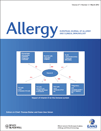Immunotherapy with oligomannose-coated liposomes ameliorates allergic symptoms in a murine food allergy model
Edited by: Angela Haczku
Abstract
Background:
Allergen-specific immunotherapy has been anticipated to be a disease-modifying therapy for food allergies. We previously reported that CD8+ regulatory T cells may prevent antigen-sensitized mice from developing allergic diarrhea. Because oligomannose-coated liposomes (OML) have been shown to induce MHC class I-restricted CD8+ T cell responses, we analyzed the adjuvant activities of OML for inducing regulatory CD8+ T cells and mucosal tolerogenic responses in allergen-sensitized mice.
Methods:
The BALB/c mice that were previously sensitized to ovalbumin (OVA) were intranasally immunized with OVA-encased in OML (OVA-OML) or OVA-encased in non-coated liposomes (OVA-NL). We assessed allergic diarrhea induced by oral OVA administration, OVA-specific immunoglobulin production, and cytokine production in the intestines and mesenteric lymph nodes (MLNs).
Results:
Intranasal immunization with OVA-OML, but not OVA-NL, suppressed the development of allergic diarrhea. This was associated with in vitro Ag-induced IL-10 production and the in vivo expansion of CD8+ CD28− and CD4+ CD25+ Foxp3+ T cell populations among mesenteric lymph node mononuclear cells, and was significantly ablated by anti-SIGNR1 or anti-CR3 mAbs. Up-regulation of serum OVA-specific IgE was suppressed, whereas OVA-specific IgG1, IgG2a, and soluble IgA production were enhanced by intranasal administration of OVA-OML. Adoptive transfer of CD8+ CD28− T cells but not CD28+ CD8+ T cells from the MLNs of OVA-OML-treated mice ameliorated the development of diarrhea.
Conclusion:
These results suggest that intranasal immunization with Ag-encased OML may be an effective immunotherapy for food allergies, as it induces a subset of regulatory CD8+ T cells as well as CD4+ CD25+ Foxp3+ T cell and modulates humoral immune responses in allergen-sensitized mice.




